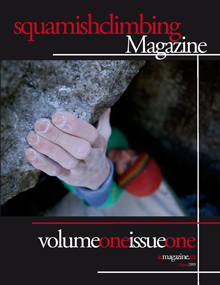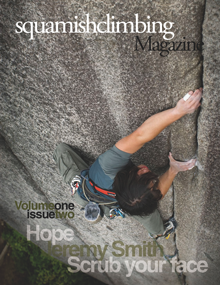With Tour De Bloc this weekend in both Vancouver and Montreal, we thought it would be a great idea to interview Simon Parton, who placed first last October during Tour De Bloc 12 at The Hive in Vancouver.
Simon Parton has always been a dark horse in the west coast climbing scene. He started climbing in 1999 only later to join the famous ‘Edge Team’ in 2001. In his early days, Simon was the Junior Lead National Champion in 2006 and went on to compete in three Youth World Championships.
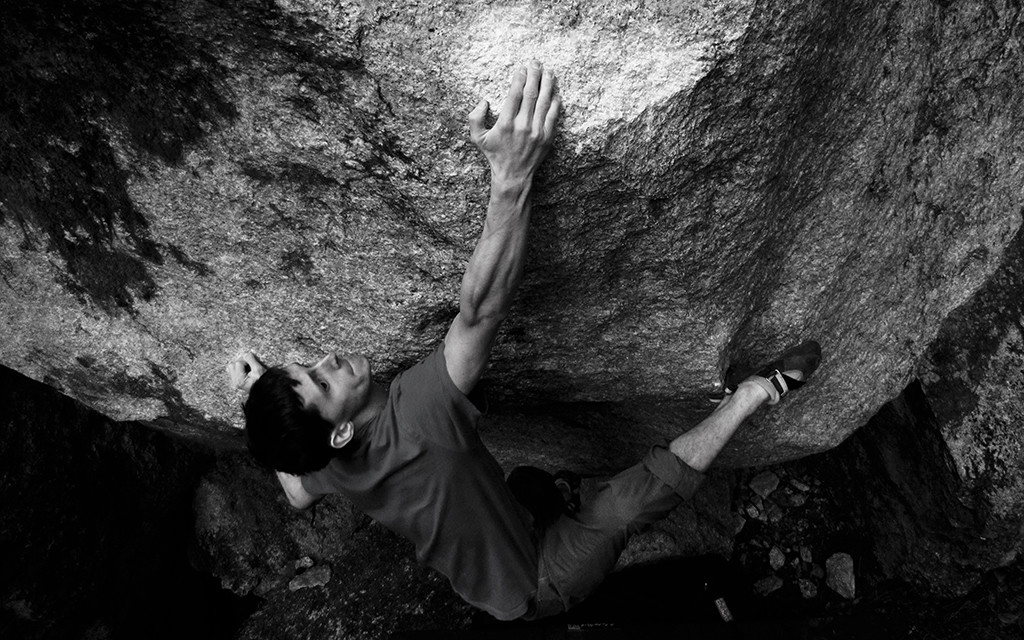
Simon Parton on Velco Low (v13). Photo by Ayesha Khan ©
After aging out of the ‘Edge Team’, Simon started to train on his own making quick gains year after year. Finding his way to the boulders, Simon was one of the few young climbers at the time to persist in the technical style of Squamish bouldering, making a number of difficult sends including the third ascent of Velco Low (v13). With both his technical ability and mutant crimp strength, Simon went on to send two classic Fred Nicole test-pieces, Terre de Sienne (v14) in Hueco Tanks and, most recent, Amandla (v14) in Rocklands, both second try.
Now, as the Head Routesetter for The Edge Climbing Centre and for a number of Sport Climbing BC events, Simon has found his way behind the scenes in the competition community of BC. With so much experience over the years, from a junior competitor to being one of the top boulderers in the country, we thought it would be interesting to see what he had to say on the upcoming Tour De Bloc and the progress of his own climbing.

Simon Parton. Photo by Ken Chow ©
Hey Simon, thanks for taking the time to talk to us! So, another year of Tour de Bloc! How do you feel going into the first competition of the year?
This will be my second competition of the season. I feel good, I’ve been training with the new Climb Base 5 Open Team since early September which has been great for motivation. None of us on the team are ready for competitions at this point in our training but we try to go into early events likes these with expectations that reflect where we are in our training. I must admit though it’s still hard not to feel a small amount of pressure since this comp as gone fairly well for me the last 3 times in row.

Top of #4 last year. Photo by Ken Chow ©
Last year, I remember you fighting so hard for the last problem! Can you tell us a bit about your experience last year and how that helps you going forward?
The last boulder in finals is more of a mental game than physical, mostly because I know I don’t have a lot of physical left to give so every attempt is precious. I’m pretty decent at reading the crowd, you can tell a lot about where other competitors are getting, crowds are not very subtle when it comes to valuable information. So I had a pretty good idea that I had around two tries to do the last problem and that a few competitors had had a similar final round to me in terms of attempts. This definitely adds to the stress of the flash attempt, knowing it could be the difference between winning or even knocking you off of the podium. I managed to use the stress well this time and was able to flash the last problem despite missing a jump but landing back on the volume I jumped off of, which was a very bizarre feeling. Having success in previous events is a great booster for me , because I know if there is a time where I feel up against a wall or I ever start to feel like “I can’t”, I can think to myself that “I can”, “I have”, and “I will”. It helps me reset and refocus.

After the final problem last year at TDB12. Photo courtesy of Simon Parton ©
Tour De Bloc is one of the competitions that you do get a chance to compete in rather than being a part of the setting team. Will this year be the same or will you get a chance to focus on one or the other?
I will be competing a little more than usual this year but I will be setting just as much as in the past. I’m already confirmed for 6 SCBC comps as Head Setter and likely even a few more before the season is over, I’m pretty excited for this season either way with some new gyms on the roster.
I want to go back a little into your climbing history. When did you first start climbing and what go you into it?
When I was about six or seven I did a week long summer camp at the edge. We learned how to climb, belay, and we even did a zip line… It was amazing. It wasn’t until I was 12 when I joined the junior program that climbing and I started going steady. I was on the junior program for a few weeks before I was invited to be on the Edge Team, and wouldn’t you know it I said no. A few more months pass, another invite goes by. I was happy where I was with the friends that I had in the junior program. Finally a year later Andrew stepped in and rather than inviting my he told me I was on the team and the rest is history.
You were part of an early Edge team with Sean McColl, Matt Johnson and JJ Mah under the tutelage of Andrew Wilson and Mike Doyle. How did this experience shape your climbing?
That was quite a time having to chase JJ, Matt, and Sean. There was no lack of motivation for sure. It was more than just them though, everywhere you looked on the team there were amazing climbers, all performing well and chasing the same goals. Then on top of all that you add Andrew and Mike as coaches with the level of professionalism they brought to climbing. Mike played the role of slave driver, he’d make you do thousands of anything, while Andrew was all about strategy and how to manage different situations. I would not be the climber or even person I am today without those six years I spent on the Edge Team, there’s no doubt about it.

Youth World Championships circa 2005 Beijing. Photo courtesy of Simon Parton ©
A number of years ago, you almost went through a rebuild of your climbing ability that really brought you to a new level. Can you tell us a bit about it?
Funnily enough, it was around my last year on the team and just after. After I aged out of the Edge Team, I continued training, holding on the the mindset that I was always chasing JJ, Matt, and Sean. Not in a personal way, more of a “they’re going to be able do one more than you, so you better do two more” way. I spent a lot of time on stuff we didn’t really do a lot of while one the team like campus board, really hard dead hangs, and things not really friendly to younger climbers. Trying to focus on my fingers which were by far my weakness at the time. I climbed in the gym five to six days a week four to five hours a day for two to three years straight. In that relatively short two year time, I went from doing V7’s like ‘A.T.D.’ to milestones like ‘the Serpent’ (v10) to ‘When Harry Met Sally’ (v12). Then in another two year,s I went on to nearly flash Terre de Sienne (v13/14) in Heuco. There’s no way I would have been able to do all that training without the foundation I built from my time on the team, not to mention all that training injury free.
How about injuries now?
I’ve been fortunate enough to never have had a major injury or at least nothing that I’ve had to take more than a few rest days for recovery. I can’t say I do anything special to say healthy. It could just be a combination of genetics, formal training, and being small.
After that time you were one of the only climbers on that team to be psyched on Squamish bouldering. Is the Squamish style a style that you are drawn to?
That’s not necessarily true, let’s not forget Will Stanhope and Jason Kruk came from the Edge Team! I definitely know what you mean though. Squamish is a very unique style that doesn’t lend it self very well to indoor climbers, it’s also notoriously hard and unforgiving. Setters often joke when they set a problem too hard they will just shrug it off as “it’s Squamish V3”. Speaking from my experience, it did take me a while to learn the Squamish style, and it was hard to keep coming back at first. When you spend most of your week training then you finally get a chance to climb outside you’ll want to have fun and have success and not really spend your time trying to figure things out. Think of it as a mini vacation from training and competitions. Then add in the fact that you’re 18 and you think you can do everything, and your motivation for Squamish crashes. Fast forward to today and I love the Squamish style and what it has to teach. If you can figure out and climb and problem in Squmaish you can literally climb anywhere.
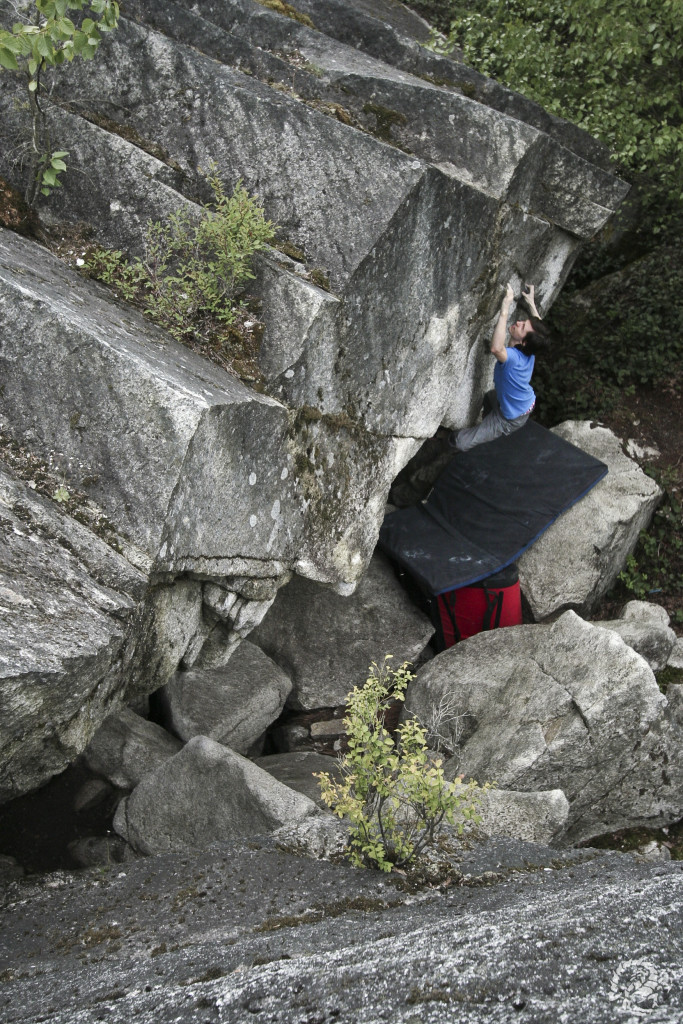
The 25th Hour. Photo by Tiffany Melius ©
From an outsider’s perspective, it seems that you sometimes struggle with motivation?
I would say my motivation ebbs and flows as much as the next climber. However, setting, as much as a I love it, can definitely destroy motivation faster than usual which is really the key difference. A tough lesson that I’m still learning is setting days are not rest days. It’s very hard to climb 4 days a week, and set 2-3 times a week. That can be as much as 7 climbing sessions a week. After joining the Climb Base 5 Open Team it’s been way easier to be motivated and stay motivated. All my training is scheduled ahead of time and setting is factored in. The key for me has been to find that point where I’m not necessarily doing as much as I would want every week so I feel that every time I go and train it’s much more important that it’s a good session.
Over the past few years you have become the Head Routesetter at The Edge and you are certified to set for World Cup competition. What made you jump into route setting and how do you think it helps you climbing?
It was kind of the next logical step for me, I’d always loved making and building things so this was just a way to combine two things I really enjoyed. Most of my time setting is spent exploring movement, seeing whats possible vs. impossible, or whats the easiest way through this sequence for this body type. It’s enabled me to see more possible sequences at once and narrow down my choices much quicker from the ground. I also have more trust in what I’ve chosen so I’m able to dedicate all my effort for that attempt on that particular sequence or change it quickly enough as not to waste energy.

Simon setting at Allez Up. Photo courtesy of Simon Parton. ©
You have travelled to other areas and have been successful on very crimpy problems. Do you enjoy the crimpy problems or do you prefer to ‘put together a puzzle’?
I like all different problems, I just happen to be a lot better a crimps than anything else and simple problems tend to get sent a lot quicker since there isn’t very much beta to figure out. We all lean towards our strengths.
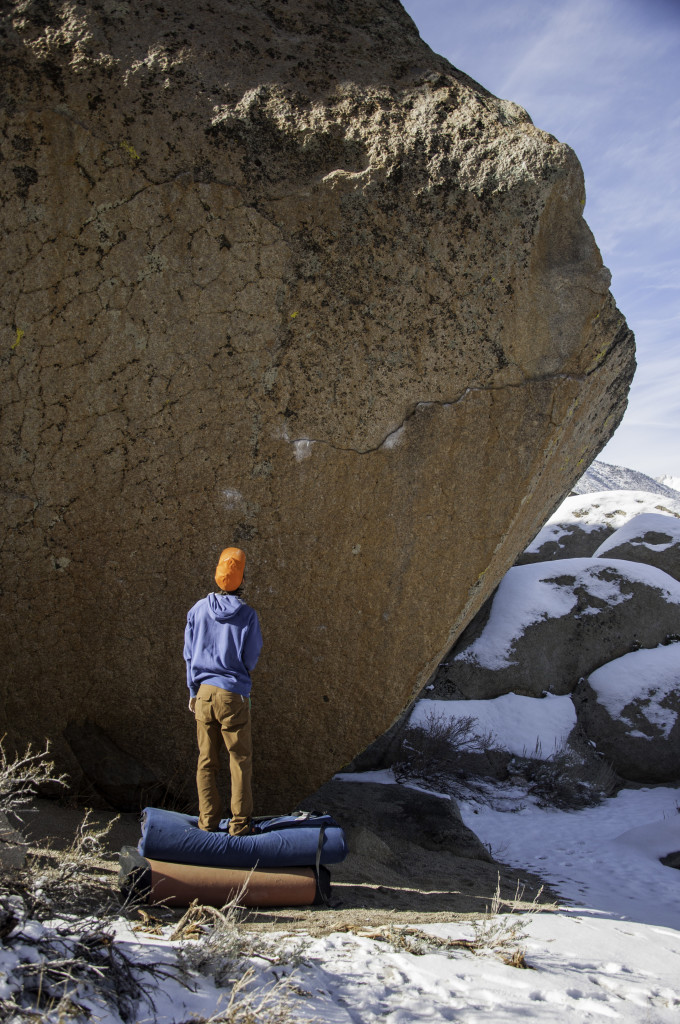
Simon pre-send of The Swarm (v14). Photo by Tiffany Melius ©
The Open Team seems to have really re-invigorated a number of climbers. What do you think the team gives you that you would otherwise not have?
For me it’s accountability. I’ve built lots of training programs for myself and I’ve also spent countless days training by myself, and I’ve been successful. The difference with the team I can’t skip training days or change training regiments when motivation is low. I have to keep pushing myself because I know at the end of the week I have a coach and the rest of the team to answer to if I’ve been light in my training
It seems as though we are in a ‘Golden’ period of BC competition. How do you think the competition scene has evolved over the past few years and where do you think it is going?
Golden age? I hope not! That implies we might be on the way down soon… We’re still on the rise from what I can see by about 10-20% attendance every year. The formation of SCBC was key, before then there was no reliable comp schedule. It came down to picking out gyms that were already hosting events and making a season out of it. Now there’s a reliable consistent season that athletes can train for or that recreational competitors know they’re going to have fun. Competitions are growing and they are getting more professional. It not about who can throw an event together and have some fun anymore. Competitors are getting more serious, the field is getting more packed, and the stakes are higher. There were a few times last year where I could not predict who was going to be in finals let alone be on the podium.

An Uncooperative set screw at SCBC Boulder Provincials 2015. Photo courtesy of Simon Parton ©
Setting boulders and routes week after week, where do you keep coming up with your ideas?
Setters block doesn’t happen too often for me because there are so many different ways to approach setting that if I ever find myself low on ideas I can just change my approach and refresh my brain so to speak. If all else fails, google it. World Cup videos are a great source of inspiration. Since you can never copy a boulder problem exactly, a re-creation will always ends in something different than intended.
You recently did a trip to Rocklands. How was the experience there?
I can’t wait to go back. It’s not unlike Squamish with its dramatic reveal of the chief has you drive over the hill. Just replace the chief with fields upon fields of black and orange boulders. It’s hard to get a scale of it until you’ve seen it in person. The quality and quantity of the climbing is like nowhere else I’ve climbed. The setting is beautiful too, it’s just a nice place to be. After seeing Amandala in the movie Progression (2009), watching Paul Robinson and Daniel Woods trying it, I would dream about getting a chance to try it. Then to not only do it, but do it second try was more than a dream come true for me. I managed to send Amandala pretty early in the trip, day three or so, which left me in a bit of an “okay, now what?” situation. It made the rest of the trip quite an experience, spending my time just climbing everything I could. No saving energy for the next attempt, no conserving skin, and not worrying about proper rest days. It was one of the more liberating climbing trips I had been on.

Random boulder in Rocklands. Photo by Tiffany Melius ©
What is next on your horizon?
First, gearing up to set this SCBC season. Then this winter I’ll be making trip through Bishop to Hueco. I’ve got some problems down there I’d like to do, goals that I’ve been working towards as part of the Base 5 Open Team, like Mandala SDS, Nagual, and Terremer.
Do you ever think of jumping on a rope?
Every so often, but it never happens. I like bouldering too much. I think the last time I was on a rope outside of setting was when Sean did Dreamcatcher. Most of my time as a youth competitor was spent on a rope, I just got burned out.
I want to talk about training a little bit because it is the latest rage but you have been at it for a long time. What are some of your favourite training exercises and where do you think most climbers find weakness?
The best and easiest way to find your weakness is to think about what you don’t like climbing on. If you don’t like climbing on slopers, there’s a good chance you’re not relatively good at them. As far as exercises, at the end of the day it doesn’t really matter what you do. What matters is that you do them well and often. Try to balance exercises you enjoy with one you don’t, build a regimented plan with mandatory rest, and don’t burn yourself out. You’ll get more out moderate training that lasts months rather than intense training that you can only keep up for a week.
Lastly, Andrew Wilson and Mike Doyle certainly played a mentor role in a number of youth competitors that came out of The Edge. Is there anything that they said or did that sticks with you?
We often look like fools when trying to learn a new skill or break down old and outdated patterns. We might look silly trying certain exercises. It might even seem ridiculous to some that we’re spending countless hours on seemingly insignificant details. Andrew reminds us every week at Saturday training to just be comfortable in doing what we’re doing and to look past what others may think. He simply says “embrace your geekdom.”

Simon and Andrew. Photo courtesy of Simon Parton ©
Thanks Simon, great answers and insight. Good Luck tomorrow at Tour De Bloc 13 and best of luck for the rest of the year.











